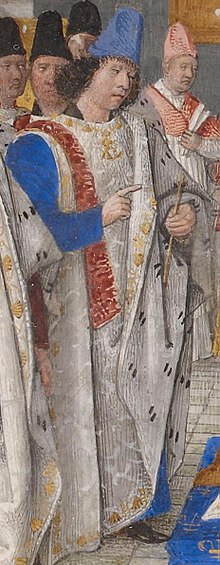Antoine de Chabannes | |
|---|---|
| Count of Dammartin, Lord of Puisaye, etc. | |
 Antoine de Chabannes depicted in the Statuts de l'ordre de Saint-Michel, attributed to Jean Fouquet, ca. 1470 | |
| Born | 1408 Charlus-le-Pailhoux |
| Died | December 25, 1488 Dammartin-en-Goële |
| Buried | Dammartin-en-Goële (body); Saint-Fargeau (heart) |
| Noble family | House of Chabannes |
| Wife | Marguerite de Nanteuil (ca. 1422-1475) |
| Issue | Jean de Chabannes (1462-1503); Gilbert, Jeanne, Jacqueline, Anne (dates unknown); Jacques, Hélène, Marie (illegitimate) |
| Father | Robert de Chabannes |
| Mother | Alix de Bort |
Antoine de Chabannes (1408–1488), from 1439 Count of Dammartin (with a gap in 1463–1465), was a significant military and political figure of 15th-century France. An indefatigable fighter, during his long career he joined or led numerous military campaigns all over France and beyond. He served the French Valois kings Charles VII, Louis XI and Charles VIII, but also participated in two aristocratic uprisings, the Praguerie against Charles VII in 1440 and the War of the Public Weal in 1465 against Louis XI. Associated early in his life with the Armagnac faction, he fought in Charles VII's campaigns against England, including those involving Joan of Arc, and (except for a troubled period in the early 1460s) also remained generally opposed to the Burgundians and their Habsburg successors. 18th-century scholar Charles Pinot Duclos described him as "one of the bravest men of his time, sincere, faithful, quick-tempered, a keen friend and implacable enemy" (un des plus braves hommes de son temps, sincère, fidèle, naturellement emporté, ami vif et implacable ennemi).[1] Claude Villaret called him "the most experienced general of his era" (le général le plus expérimenté de son siècle).[2]
His reputation has been tainted by his late-1430s freebooting écorcheur raids and by his avidity in appropriating properties of the disgraced Jacques Coeur in the early 1450s, mainly the lordship of Puisaye which Coeur's successors tried to reclaim in legal procedures that extended beyond Chabannes's lifetime. His rule in Puisaye, however, coincided with the revival of that region following the ravages of the Hundred Years' War and the broader Crisis of the Late Middle Ages.